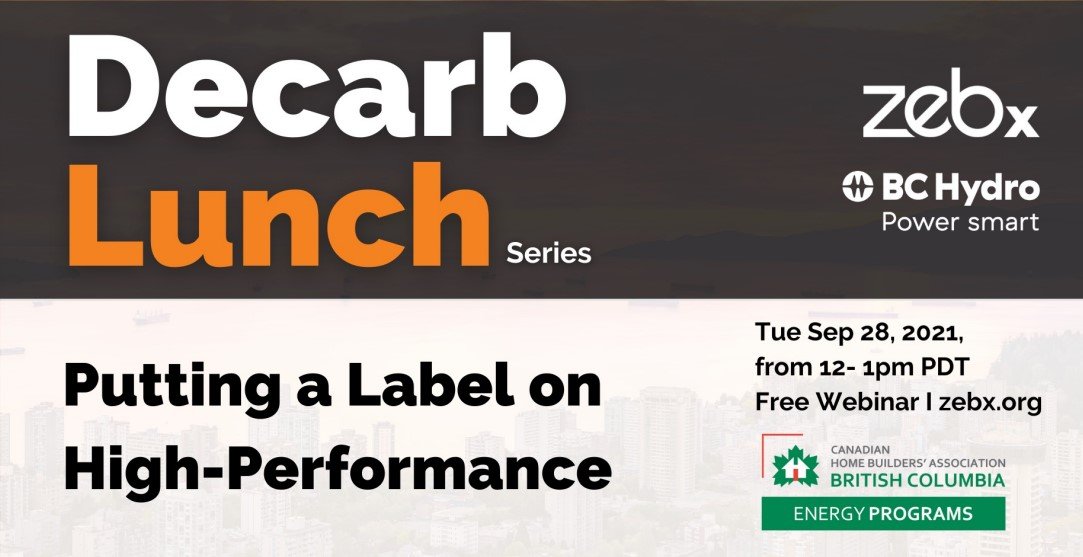
Zero Emissions Buildings
PUTTING A LABEL ON HIGH-PERFORMANCE
This event was a collaboration with the Canadian Home Builders Association BC and featured speakers from Naikoon Contracting and Averra Developments.
In November 2020, the Premier’s mandate letter to the Minister of Finance mentioned that in the future, real estate listings will be required to include energy efficiency information on listed homes. Among CHBA’s offerings for certification is the Net Zero Home Labelling Program. At this event, ZEBx and CHBA-BC showcased two solar-powered Net Zero Energy homes from ZEBx’s NearZero Emissions Building Program and the speakers gave valuable insights.
PRESENTATION EVENT: BC’S BUILDING ELECTRIFICATION ROAD MAP
The Building Electrification Road Map was launched at this online event to about 130 participants and stakeholders who had contributed in the Road Map creation. This slide deck is an open resource from this presentation, available to view and share.
The objectives of the event which are outlined in the slide deck were to:
• Present the Road Map and key components and outcomes
• Build momentum among key stakeholders for its implementation
• Provide updates of ongoing work linked with Road Map actions/strategies
• Share the timeline for next steps and outline a call to action for ongoing involvement
MARKETING THE HIGH-PERFORMANCE HOME
Builders, architects, developers, and marketing professionals must all communicate energy and climate performance. Here’s how.
Even a few years ago, those in the market for a new home didn’t think much about what was going on inside the walls. Energy performance upgrades were firmly on the “nice-to-have” list, behind features such as walk-in closets and kitchen-island prep sinks.
But that’s changing. The climate emergency is now front of mind for British Columbians, and more homebuyers want to be part of the solution. Energy performance loomed large in the 2020 Canadian Home Builders Association (CHBA) national survey of buyer preferences. In a Top 10 list of most desirable features in a new home, four directly relate to increased energy performance.
CHBA NET ZERO HOME LABELLING PROGRAM
The CHBA Net Zero Home Labelling Program has been running since its pilot in 2015 and has labelled over 600 homes in Canada to date. The Program provides the industry and consumers with a clearly defined and rigorous two-tiered technical requirement that recognizes Net Zero and Net Zero Ready Homes, and the builders and renovators who provide them. A national network of CHBA Qualified Net Zero Service Organizations, Energy Advisors work directly with the builders and renovators to design, model, test and inspect each home. Net Zero Training courses, delivered by CHBA Qualified Net Zero Trainers, are also a key component to the success of the Program Participants.
QUANTIFYING EMBODIED CARBON FOR BUILDINGS OF THE FUTURE
Society is facing a climate crisis. Over 30 municipalities in British Columbia have declared a climate emergency so far and some have begun taking significant steps to address the climate crisis. The most effective way to address this climate crisis is to focus on greenhouse gas emissions. But which type? In the buildings sector, embodied emissions are the now. Operational emissions are the maybe later. With this in mind, some municipalities are beginning to buckle down on embodied emissions.
Leading this charge is the City of Vancouver, with plans to set increasingly stringent embodied emissions targets, starting next year, so that by 2030, the embodied emissions from new buildings will be reduced by 40% compared to buildings built in 2018. What this means for you is simple: quantifying embodied emissions in new buildings will become the norm in very short order. Join ZEBx for our next Decarb Lunch; We’ll be focusing on some of the different lifecycle assessment tools available today, and embodied emissions results for high-performance Part 9 and Part 3 buildings of the future.
BUILDING A HIGH-PERFORMANCE HOME – DOES IT COST MORE?
The Province’s CleanBC Plan charts a course for net-zero energy-ready homes by 2032. That’s Step 5 of the BC Energy Step Code for Part 9 buildings. Between now and then, the CleanBC Plan sets Step 3 as a minimum requirement by 2022 and Step 4 by 2027. If clients are concerned about future-proofing the value of their new home, they may ask about the difference in cost between a code-minimum home and one that meets the 2027 or 2032 requirements.
How does a builder approximate this difference? NRCan’s Cost Benefit Analysis Tool (CBAT) is a powerful and free Excel-based costing tool that can help the Part 9 building community approximate the cost of high-performance homes of the future. Join ZEBx and HAVAN on Friday, May 28 as we present the CBAT along with some real-world insight into how it’s been used.






